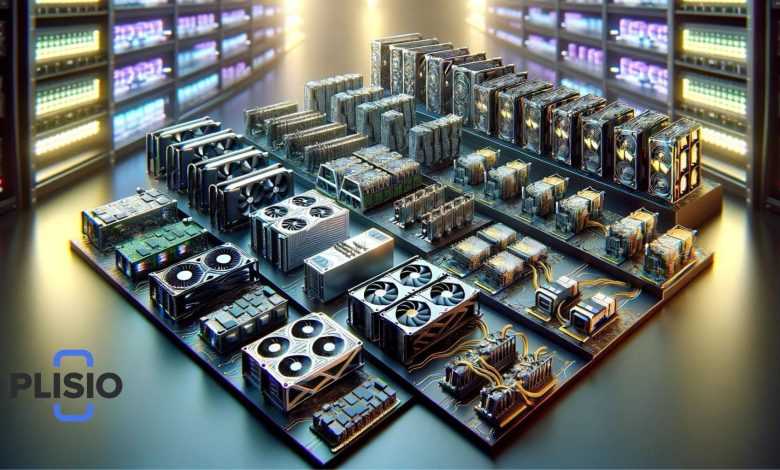Performance Analysis of Crypto Mining Rigs

- Understanding the Components of Crypto Mining Rigs
- Optimizing Hash Rates for Maximum Efficiency
- Comparing GPU vs ASIC Mining Rigs
- Calculating the ROI of Crypto Mining Rigs
- Troubleshooting Common Issues with Mining Rigs
- Exploring the Future of Crypto Mining Technology
Understanding the Components of Crypto Mining Rigs
Crypto mining rigs are complex systems composed of various components that work together to mine cryptocurrencies efficiently. Understanding the key components of these rigs is essential for optimizing their performance and maximizing profits.
- Graphics Processing Unit (GPU): The GPU is the most crucial component of a mining rig, responsible for performing the complex mathematical calculations required for mining. High-end GPUs with a high hash rate are preferred for faster mining.
- Central Processing Unit (CPU): While the CPU is not as critical as the GPU for mining, it still plays a role in managing the overall system and supporting the GPU. A powerful CPU can help improve overall system performance.
- Motherboard: The motherboard serves as the backbone of the mining rig, connecting all the components together. It is essential to choose a motherboard that supports multiple GPUs for scalability.
- Memory (RAM): Sufficient RAM is necessary to ensure smooth operation of the mining rig. It helps in storing and accessing data quickly, improving overall performance.
- Power Supply Unit (PSU): A high-quality PSU is crucial for providing stable power to the mining rig. It should have enough wattage to support all components and be energy-efficient to reduce operating costs.
- Storage: Storage is needed to store the operating system and mining software. Solid State Drives (SSDs) are preferred for faster boot times and data access.
- Cooling System: Mining rigs generate a lot of heat due to continuous operation. A robust cooling system, including fans or liquid cooling, is essential to prevent overheating and ensure the longevity of components.
By understanding the role of each component in a crypto mining rig, miners can make informed decisions when building or upgrading their rigs. Investing in high-quality components can lead to better performance, increased mining efficiency, and ultimately higher profits in the competitive world of cryptocurrency mining.
Optimizing Hash Rates for Maximum Efficiency
To optimize the hash rates of your crypto mining rigs for maximum efficiency, it is essential to consider various factors that can impact performance. One key aspect to focus on is the hardware configuration of your mining rig. Ensuring that you have the right combination of components, such as a powerful GPU, sufficient RAM, and a high-quality power supply, can help boost your hash rates significantly.
Another crucial factor to consider is the cooling system of your mining rig. Overheating can lead to decreased performance and even hardware failure. By investing in proper cooling solutions, such as fans or liquid cooling systems, you can ensure that your rig operates at an optimal temperature, allowing for higher hash rates.
Additionally, optimizing the software settings of your mining rig can also play a significant role in maximizing efficiency. Tweaking parameters such as clock speeds, memory timings, and power limits can help fine-tune your rig for better performance. It is essential to regularly monitor and adjust these settings to adapt to changing market conditions and algorithm updates.
Furthermore, considering the electricity costs associated with mining is crucial for maximizing efficiency. By choosing energy-efficient components and mining during off-peak hours when electricity rates are lower, you can reduce operational costs and increase your overall profitability.
In conclusion, optimizing hash rates for maximum efficiency requires a holistic approach that considers hardware configuration, cooling systems, software settings, and electricity costs. By carefully managing these factors, you can ensure that your crypto mining rig operates at peak performance, maximizing your potential earnings in the competitive world of cryptocurrency mining.
Comparing GPU vs ASIC Mining Rigs
When comparing **GPU** and **ASIC** mining rigs for **cryptocurrency** mining, it is essential to consider various factors that can impact their **performance**. **GPU** mining rigs are versatile and can mine a wide range of **cryptocurrencies**, making them a popular choice among **miners**. On the other hand, **ASIC** mining rigs are specifically designed to mine a single **cryptocurrency** algorithm, offering higher **hash rates** and **efficiency**.
**GPU** mining rigs are more accessible and easier to set up compared to **ASIC** rigs, which require specialized knowledge and technical skills. **GPU** rigs are also more flexible and can be easily reconfigured for different **cryptocurrencies**, providing **miners** with more options. However, **ASIC** rigs are more **efficient** in terms of **power consumption** and **hash rates**, making them more **profitable** in the long run.
In terms of **performance**, **ASIC** mining rigs outperform **GPU** rigs in **hash rates** and **efficiency**. **ASIC** rigs are specifically designed to mine a single **cryptocurrency** algorithm, allowing them to achieve higher **hash rates** compared to **GPU** rigs. This higher **efficiency** translates to lower **power consumption** and higher **profitability** for **miners** using **ASIC** rigs.
While **GPU** rigs are more versatile and can mine a wider range of **cryptocurrencies**, they are less **efficient** and consume more **power** compared to **ASIC** rigs. **GPU** rigs are better suited for **miners** who want to mine multiple **cryptocurrencies** or experiment with different **mining** algorithms. On the other hand, **ASIC** rigs are ideal for **miners** who are focused on **mining** a single **cryptocurrency** and maximizing their **profitability**.
In conclusion, the choice between **GPU** and **ASIC** mining rigs depends on the specific needs and goals of the **miner**. **GPU** rigs offer versatility and flexibility, while **ASIC** rigs provide higher **efficiency** and **hash rates**. **Miners** should consider their **mining** objectives, budget, and technical expertise when deciding between **GPU** and **ASIC** rigs for **cryptocurrency** mining.
Calculating the ROI of Crypto Mining Rigs
When it comes to evaluating the profitability of crypto mining rigs, calculating the return on investment (ROI) is crucial. This involves analyzing the initial cost of setting up the mining rig against the potential revenue generated from mining cryptocurrencies. By determining the ROI, miners can assess whether the investment in mining hardware is worthwhile.
There are several factors to consider when calculating the ROI of crypto mining rigs. These include the cost of the mining rig itself, electricity expenses, mining difficulty, hash rate, and the current price of the cryptocurrency being mined. By taking all these variables into account, miners can estimate the potential profitability of their mining operation.
One way to calculate the ROI of a mining rig is to use online calculators specifically designed for this purpose. These calculators take into consideration factors such as electricity costs, hash rate, and mining difficulty to provide an estimate of the potential ROI. By inputting relevant data into these calculators, miners can get a better understanding of the profitability of their mining rig.
Troubleshooting Common Issues with Mining Rigs
When it comes to mining rigs, there are common issues that can arise and affect their performance. Here are some troubleshooting tips to help you address these problems:
- Overheating: One of the most common issues with mining rigs is overheating, which can lead to decreased performance or even hardware failure. Make sure your rig is properly ventilated and consider adding additional cooling fans or an external cooling system.
- Hardware Malfunction: If your mining rig is experiencing hardware malfunctions, such as a faulty GPU or ASIC, try replacing the problematic component with a new one. Regularly check for loose connections or damaged parts that may be causing issues.
- Power Supply Problems: Insufficient power supply or a faulty PSU can also impact the performance of your mining rig. Make sure your power supply unit is providing enough power for all components and consider upgrading to a higher wattage PSU if needed.
- Software Glitches: Sometimes, software glitches or compatibility issues can cause your mining rig to underperform. Update your mining software to the latest version and ensure that all drivers are up to date. Consider switching to a different mining software if the problem persists.
- Network Connectivity: Poor network connectivity can result in mining interruptions and lower hash rates. Check your internet connection and consider using a wired connection for more stability. You can also try switching to a different mining pool to see if that improves performance.
By addressing these common issues with mining rigs, you can optimize the performance of your rig and maximize your mining profits. Regular maintenance and troubleshooting are essential to ensure that your rig is running smoothly and efficiently.
Exploring the Future of Crypto Mining Technology
As we look towards the future of crypto mining technology, it is clear that advancements in hardware and software will continue to drive innovation in this space. One key area of focus is improving the efficiency and performance of mining rigs to maximize profitability for miners. Companies are constantly developing new mining rigs that offer higher hash rates, lower power consumption, and increased reliability.
One trend that is gaining traction in the crypto mining community is the use of ASIC (Application-Specific Integrated Circuit) mining rigs. These specialized devices are designed specifically for mining cryptocurrencies and offer significant performance improvements over traditional GPU-based rigs. While ASIC miners can be more expensive upfront, they often provide a higher return on investment due to their increased efficiency.
Another area of interest is the development of mining rigs that are optimized for specific cryptocurrencies. By tailoring hardware and software to the unique requirements of a particular cryptocurrency mining algorithm, miners can achieve higher hash rates and lower power consumption. This level of customization can result in a significant competitive advantage in the crypto mining space.




